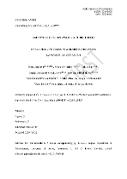| dc.contributor.author | Jandová, Soňa | |
| dc.contributor.author | Gajdoš, Miloslav | |
| dc.contributor.author | Čuj, Jakub | |
| dc.contributor.author | Kendrova, Lucia Demjanovič | |
| dc.contributor.author | Mikuľákova, Wioletta | |
| dc.date.accessioned | 2024-12-19T13:10:47Z | |
| dc.date.available | 2024-12-19T13:10:47Z | |
| dc.date.issued | 2024 | |
| dc.identifier.uri | https://hdl.handle.net/20.500.14178/2768 | |
| dc.description.abstract | Background. The aim of the work was to ascertain the differences in the temporal characteristics of the gait cycle of slow walking in high heels. The study particularly focusedon a group of women who started to wear high heels more often. Material and methods. The Pedar X System (Novel, Germany) was used to analyze thetemporal characteristics of the gait cycle. Average values of temporal variables in both feet were ascertained based on the measured functions of maximal peak pressure (PPmax) andmaximal vertical force (MVFmax) depending on time.Results. Slow walking in high heels, as compared to slow walking in flat shoes, resulted in shortening the gait cycle in all its phases. This in turn increased the frequency of steps in high heels. While walking at a speed of v1=0.97 m.s-1(slow speed) and v2=0.56 m.s-1 (very slow speed), there were no differences in stance/swing ratio between high heels and flat shoes. Conclusions. Slow walking speeds can be considered to be suitable for women who have recently started walking in high-heeled shoes and have had no previous experience with them. | en |
| dc.language.iso | en | |
| dc.relation.url | http://. https://doi.org/10.5114/hpc.2024.135433 | |
| dc.rights | Creative Commons Uveďte původ-Neužívejte dílo komerčně-Zachovejte licenci 4.0 International | cs |
| dc.rights | Creative Commons Attribution-NonCommercial-ShareAlike 4.0 International | en |
| dc.title | Health Problems of Civilization Physical activity: diseases and issues recognized by the WHO | en |
| dcterms.accessRights | openAccess | |
| dcterms.license | https://creativecommons.org/licenses/by-nc-sa/4.0/legalcode | |
| dc.date.updated | 2025-04-01T05:40:55Z | |
| dc.subject.keyword | walking speed | en |
| dc.subject.keyword | stride | en |
| dc.subject.keyword | swing | en |
| dc.subject.keyword | shoes | en |
| dc.subject.keyword | pressure | en |
| dc.identifier.eissn | 2354-0265 | |
| dc.relation.fundingReference | info:eu-repo/grantAgreement/UK/COOP/COOP | |
| dc.date.embargoStartDate | 2025-04-01 | |
| dc.type.obd | 73 | |
| dc.type.version | info:eu-repo/semantics/publishedVersion | |
| dc.identifier.doi | 10.5114/hpc.2024.135433 | |
| dc.identifier.utWos | 001451670000007 | |
| dc.identifier.eidScopus | 2-s2.0-86000794263 | |
| dc.identifier.obd | 651529 | |
| dc.subject.rivPrimary | 50000::50300::50301 | |
| dcterms.isPartOf.name | Health Problems of Civilization | |
| dcterms.isPartOf.issn | 2353-6942 | |
| dcterms.isPartOf.journalYear | 2024 | |
| dcterms.isPartOf.journalVolume | 18 | |
| dcterms.isPartOf.journalIssue | 2 | |
| uk.faculty.primaryId | 117 | |
| uk.faculty.primaryName | Pedagogická fakulta | cs |
| uk.faculty.primaryName | Faculty of Education | en |
| uk.department.primaryId | 1581 | |
| uk.department.primaryName | Katedra tělesné výchovy | cs |
| uk.department.primaryName | Department of Physical Education | en |
| dc.description.pageRange | 1-17 | |
| dc.type.obdHierarchyCs | ČLÁNEK V ČASOPISU::článek v časopisu::původní článek | cs |
| dc.type.obdHierarchyEn | JOURNAL ARTICLE::journal article::original article | en |
| dc.type.obdHierarchyCode | 73::152::206 | en |
| uk.displayTitle | Health Problems of Civilization Physical activity: diseases and issues recognized by the WHO | en |

